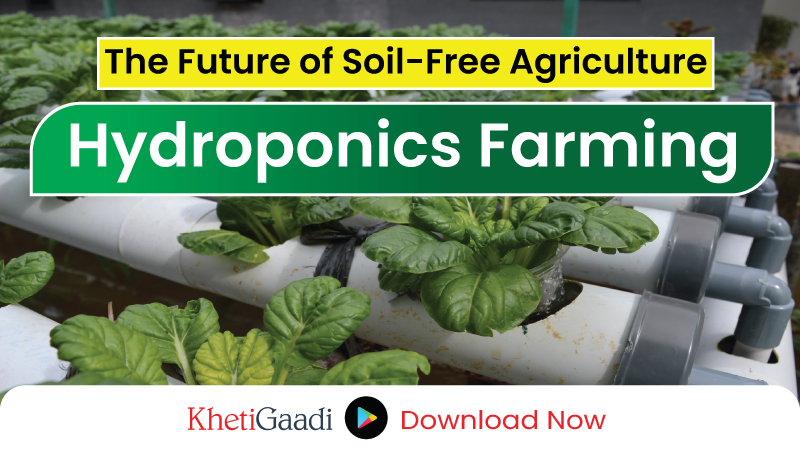As we stand on the cusp of a new agricultural era, the way we grow our food is undergoing a significant transformation. Traditional farming, which has long relied on soil, is being reimagined with innovative techniques that not only boost productivity but also address some of the most pressing environmental challenges. One such technique that is rapidly gaining popularity in India and around the world is hydroponics – an advanced method of soil-free farming.
In this blog, we’ll dive deep into the world of hydroponics, explore its benefits, and discuss its potential to revolutionize agriculture. We’ll also highlight two success stories from India, provide practical insights into starting a hydroponic farm, and offer links to additional resources for those interested in this innovative approach.
What is Hydroponics?
Hydroponics is a method of growing plants without soil, using nutrient-rich water to deliver essential nutrients directly to the plant roots. This system allows for precise control over the growing environment, enabling plants to thrive in a highly optimized setup. Unlike traditional farming, where plants rely on soil to obtain nutrients, hydroponics ensures that plants receive everything they need in the right amounts, resulting in healthier and faster-growing crops.
In a typical hydroponic system, plants are placed in a series of pipes or trays where water is continuously circulated. This water is enriched with a balanced mix of nutrients, which are absorbed directly by the plant roots. Because the plants don’t have to expend energy searching for nutrients in the soil, they can focus all their resources on growth and development.
The Growing Popularity of Hydroponics in India
Hydroponics is still in its early stages in India, but the signs of growth are promising. As urbanization spreads and the availability of arable land decreases, hydroponics offers a viable alternative for producing fresh, nutritious food in smaller spaces. The ability to grow crops year-round, regardless of the season, makes hydroponics particularly attractive in regions with harsh climates or limited growing seasons.
In urban areas, where space is at a premium, hydroponic farms are popping up in rooftops, basements, and even repurposed shipping containers. These farms not only provide fresh produce to local communities but also reduce the environmental impact associated with traditional farming, such as soil degradation and excessive water use.
Benefits of Hydroponics
1. Optimal Nutrition and Faster Growth
One of the most significant advantages of hydroponics is the ability to deliver nutrients directly to the plant roots. In soil-based farming, nutrients can become trapped in the soil, making them less available to the plants. Hydroponics eliminates this problem, ensuring that plants receive a steady supply of the nutrients they need for optimal growth. As a result, hydroponic crops often grow faster and produce higher yields than their soil-grown counterparts.
2. Space Efficiency
Because hydroponics doesn’t rely on soil, it allows for more creative and efficient use of space. Vertical farming, a popular application of hydroponics, involves stacking layers of crops in a vertical arrangement, maximizing the use of available space. This is particularly beneficial in urban environments, where land is scarce and expensive. Commercial hydroponic farms can produce a large amount of food in a small footprint, freeing up more land for other uses or preserving natural habitats.
3. Water Conservation
Hydroponics is highly efficient in its use of water, making it an ideal solution for regions where water is scarce. Traditional farming methods often require large amounts of water, much of which is lost to evaporation or runoff. In contrast, hydroponics recycles water within the system, reducing overall water usage by up to 90%. This not only conserves water but also reduces the environmental impact of agriculture, particularly in areas where water resources are limited.
4. Reduced Environmental Impact
Hydroponics also helps mitigate the environmental issues associated with traditional farming. By eliminating the need for soil, hydroponics avoids problems like soil erosion and nutrient depletion, which are common in conventional agriculture. Additionally, because the nutrient-rich water in hydroponics is contained within the system, there is no risk of fertilizer runoff contaminating nearby water sources. This makes hydroponics a more sustainable option, particularly in sensitive ecosystems.
5. Year-Round Production
One of the most compelling benefits of hydroponics is the ability to grow crops year-round. By using artificial lighting and climate control systems, hydroponic farms can maintain optimal growing conditions regardless of the weather outside. This ensures a consistent supply of fresh produce throughout the year, reducing the need for seasonal imports and helping to stabilize food prices.
6. Local Production and Reduced Carbon Footprint
Hydroponics supports local food production, reducing the distance that food must travel from farm to table. This not only ensures fresher produce for consumers but also cuts down on the fossil fuels used in transportation. As a result, hydroponics can significantly reduce the carbon footprint associated with food production and distribution.
The Economics of Hydroponics
While the benefits of hydroponics are clear, it’s important to understand the economic aspects of this farming method. Setting up a hydroponic farm requires a significant initial investment, particularly in specialized equipment such as grow lights, nutrient delivery systems, water filtration units, and climate control devices. However, this upfront cost can be offset by the long-term benefits of higher yields, faster crop growth, and reduced operational costs.
1. Initial Investment
The capital costs of setting up a hydroponic farm can be substantial, but investing in high-quality equipment is essential for maximizing resource efficiency and ensuring the long-term viability of the farm. This guide from Agrifarming provides a detailed cost analysis of starting a hydroponic farm in India, helping potential farmers understand the financial commitment involved.
2. Operational Costs
Operational costs in hydroponics include labor, energy, and nutrients. While labor costs can be reduced through automation, energy expenses—particularly for heating and lighting—remain a significant factor. However, the potential for higher yields and faster growth rates can offset these costs, making hydroponics a profitable venture in the long run.
3. Revenue Streams
Hydroponic farmers can explore various revenue streams, including direct sales to consumers, supplying local restaurants, or partnering with wholesalers. Each of these channels has its advantages and challenges, and understanding market demand is crucial for maximizing profitability. This article from Krishi Jagran offers insights into the market potential of hydroponics in India.
4. Return on Investment (ROI)
Evaluating the return on investment (ROI) for a hydroponic farm involves analysing several factors, including crop value, operational efficiency, and market conditions. This detailed analysis from Green and Vibrant provides a comprehensive overview of the factors influencing the profitability of hydroponic farms.
Success Stories in Hydroponics
1. UrbanKisaan, Hyderabad
UrbanKisaan, based in Hyderabad, is a pioneering hydroponic farming startup that has made waves in the Indian agriculture sector. Founded in 2017, UrbanKisaan operates several hydroponic farms across Hyderabad and Bangalore, providing fresh, pesticide-free produce to local communities. Their farms use advanced hydroponic techniques, including vertical farming, to maximize space efficiency and produce a wide variety of vegetables and herbs.
By selling directly to consumers through their app and physical stores, UrbanKisaan has built a strong brand that emphasizes sustainability and health. Their success story demonstrates the potential of hydroponics to transform urban agriculture and provide fresh, healthy food to city dwellers. Learn more about UrbanKisaan.
2. Acqua Farms, Chennai
Acqua Farms, located in Chennai, is another success story in the Indian hydroponic farming space. Founded by a group of passionate entrepreneurs, Acqua Farms focuses on sustainable farming practices that minimize environmental impact while maximizing yield. Their farms produce a variety of leafy greens, herbs, and other vegetables, which are sold to local restaurants, grocery stores, and directly to consumers.
Acqua Farms has also invested in community education, offering workshops and training programs to promote hydroponic farming among aspiring farmers and enthusiasts. Their efforts have helped raise awareness about the benefits of hydroponics and inspired others to explore this innovative farming method. Visit Acqua Farms.
Getting Started with Hydroponics: Resources and Support
For those interested in starting a hydroponic farm, there are several resources available to help you get started. The Indian government offers financial assistance through schemes like the National Horticulture Mission, which supports hydroponic and other advanced farming techniques. Additionally, organizations like the Indian Council of Agricultural Research (ICAR) provide valuable research and guidance on best practices in hydroponics.
To further explore the potential of hydroponics, consider enrolling in online courses or attending workshops offered by industry leaders. Websites like Hydroponic India and Future Farms offer a wealth of information on setting up and managing a hydroponic farm.
Conclusion
Hydroponics is more than just a farming technique; it’s a vision for the future of agriculture. By eliminating the need for soil, conserving water, and reducing environmental impact, hydroponics offers a sustainable solution to the challenges of modern agriculture. As more farmers and entrepreneurs embrace this innovative method, the potential for growth and success is immense.
Whether you’re an aspiring farmer, an urban gardener, or simply someone interested in sustainable living, hydroponics offers exciting opportunities to grow fresh, healthy food in a way that benefits both people and the planet.
Tags:




